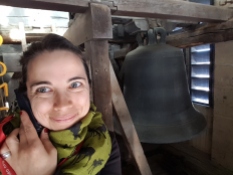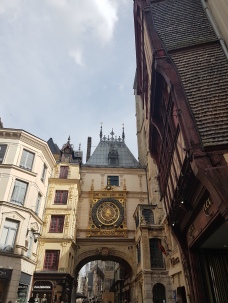The Gros Horloge (Great Clock) of Rouen is iconic of the city. It’s one of my favourite monuments of one of my favourite places in France. Many English speaking tourists to France hit up Paris, maybe the Champagne region (wine) or the Loire Valley (castles!), but if they visit Normandy normally tourists seem to skip past the interior of the region and head straight for the D-day landing beaches of the Second World War. I always encourage people to stop and explore the rest of Normandy, particularly Rouen. It’s the city where Joan of Arc was imprisoned, tried, and burned at the stake! There are narrow cobblestone streets, plus ciders, crepes, and other edible products! You can see and be photographed in front of architecture painted by Monet in the impressionist style! The beautiful Seine river that runs through Paris also runs through Rouen, but you have to deal with fewer Parisians!
The Gros Horloge itself dates from the 1300s and has an amazing little museum inside it. I really enjoyed their audioguides (available in French, English, and quite a few other languages) not only because they were informative, but also because the person speaking the audioguide claims to be the ghost of one of the former clock keepers. When he’s done talking about a particular room, he says that he’ll meet us up the stairs or wherever, and kind of implies he floats up through the ceiling. Charming!
Though it’s been run by an electric mechanism since the early 20th century, the old clockwork mechanism from the 1300s is still there, in situ, and is theoretically still in good working order if it were to be hitched back up. It was one of the earliest clocks to sound bells at the quarter of the hour, not just on the hour. The two clock faces also have black and silver globes above them that display the phase of the moon. There’s also a display showing the day of the week with Roman gods representing the day of the week: e.g., Mercury for Mecredi (Wednesday), Diana the goddess of the moon for Lundi (Monday, or the day of the “lune” / moon). In the 19th century that weekday display had been out of use for so long that it was assumed to show the signs of the zodiac! A series of reparations and restorations since the late 19th century make the Gros Horloge of Rouen an excellent functioning example of a medieval clock.
One little-known aspect of the Gros Horloge that not even all residents know is that one of the best views of the Cathedral of Rouen (famously painted by Monet) is actually from the top of the clock’s bell tower. Closed for safety reasons for many years, it reopened for the public in 2006 and have been open ever since. From there you can also see the roof of the only remaining bastion of the castle where Joan of Arc was imprisoned (now called the “Donjon” – the Dungeon). When I lived in Rouen about seven years ago, I found out that if you’re a resident of the city, when you buy your ticket you can present proof of your address and get a resident’s pass and come up any time you want to take in the view over the following year!
So please, do admire this beautiful historic clock from all angles: outside, inside, and on top!
Further Reading by Myself on Other Sites in France
- The Ossuary of St. Maclou in Rouen
- The Buttes Chaumont Park in Paris (can I draw your attention to the pun in the title of that blog post? Au Naturel/”Faux Naturel”/Falsely Natural)
- The Reims Cathedral and the effects of it being bombed during the First World War
- The Statues of Vimy Ridge











